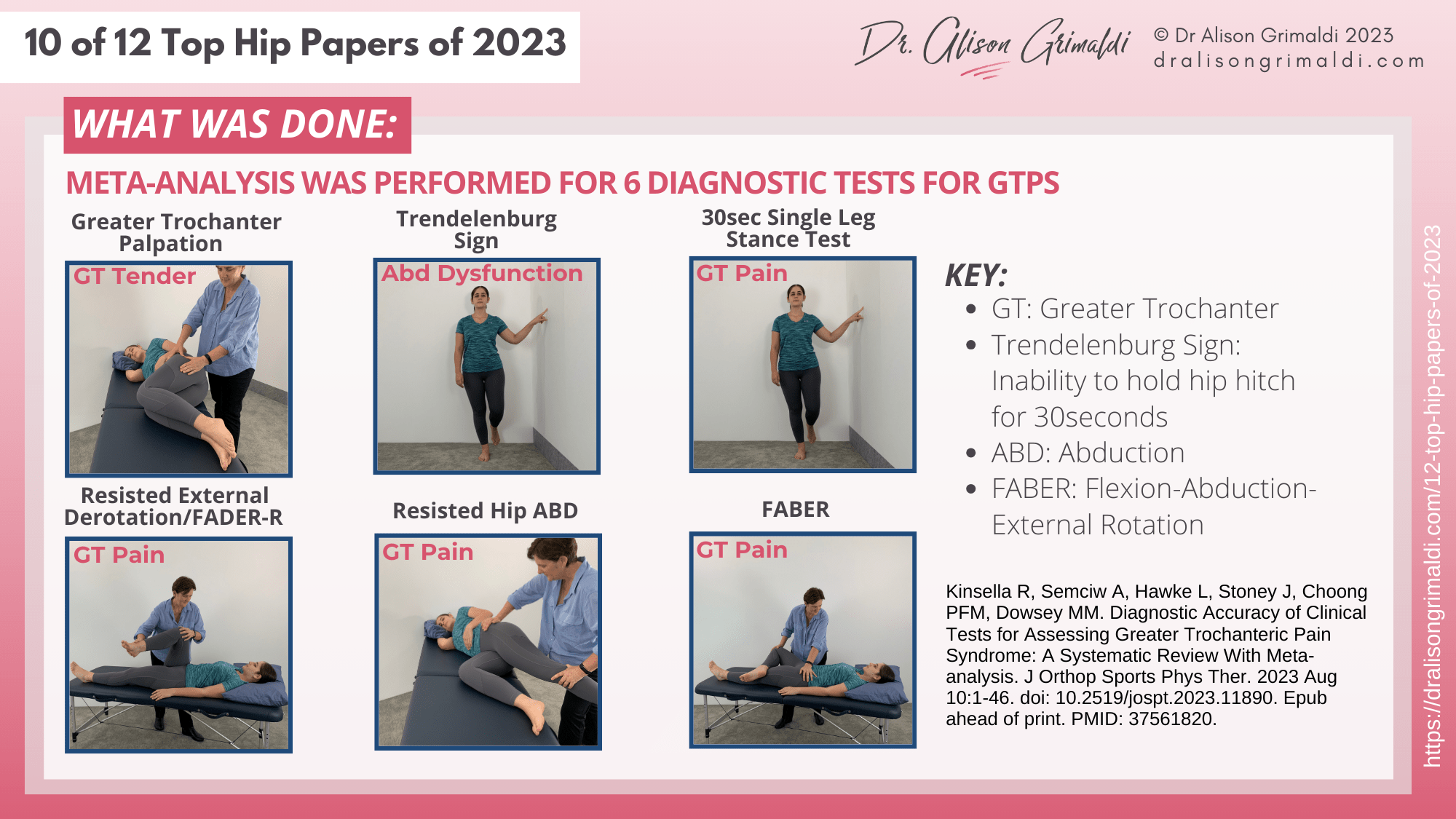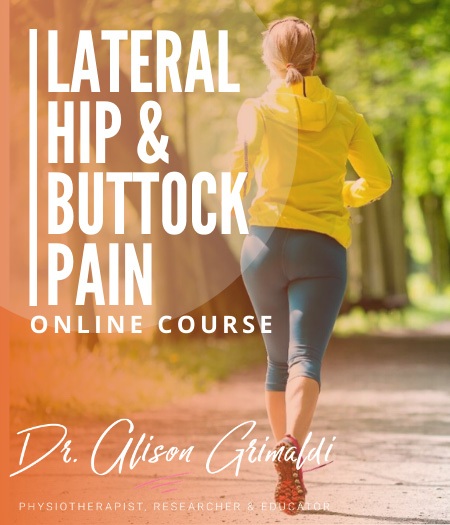10 of 12 Top Hip Papers of 2023 | Diagnostic accuracy of clinical tests for GTPS

It's day 10 of my 12 Top Hip Papers series of miniblogs for 2023! If you missed Day 9, you'll find a link at the bottom of this page to take you back. For day 10 we'll be looking at a recent systematic review and meta-analysis of diagnostic accuracy of clinical tests for GTPS (Greater Trochanteric Pain Syndrome). Below you'll find the quick and easy test battery that was recommended.

For your convenience, we have also developed this content into a FREE 31-page full colour ebook!
Packed full of 12 Top Hip Papers - peer reviewed scientific papers from 2023, that have contributed to our understanding of hip conditions and/or the assessment or management of hip pain or injury.
Can't make the workshop? Do the Online Course

10 of 12 Top Hip Papers of 2023: Diagnostic accuracy of clinical tests for GTPS1
While I prefer to use the term gluteal tendinopathy to Greater Trochanteric Pain Syndrome, as it is a more specific term reflective of the primary soft-tissue pathology associated with trochanteric pain (and less scarey for patients), this meta-analysis used the term GTPS, so we'll stick to GTPS for the purposes of this mini-blog. What we are referring to though, is soft tissue related pain over the greater trochanter, and looking at how we best diagnose this condition. There are quite a number of clinical tests for GTPS described, but in clinical practice it can be useful to know which tests combined together are most likely to give you an accurate diagnosis.
Study Aim:
- This study aimed to determine the diagnostic accuracy of clinical tests for GTPS, when compared against a reference standard such as MRI, ultrasound or surgical findings.
What was done:
- A systematic review was first conducted to collect data from all studies that had previously assessed diagnostic utility of clinical tests for GTPS or gluteal tendinopathy.
- Meta-analysis of diagnostic properties was possible for 6 tests used in diagnosing GTPS or Gluteal Tendinopathy:
- Palpation,
- Trendelenburg Sign,
- 30sec Single Leg Stance Test,
- Resisted External Derotation/FADER-Resisted Tests,
- Resisted hip abduction, and
- the FABER Test.

Key Findings: What clinical tests for GTPS are best?
- A finding of tenderness on palpation of the greater trochanter could significantly shift the post-test probability of a GTPS diagnosis in either direction. The magnitude of the shift was much greater in the negative direction.
- Resisted Abduction had a likelihood ratio that significantly shifted the post-test probability of both a positive or negative GTPS diagnosis.
- FABER and Trendelenburg tests were not able to significantly shift post-test probability of a GTPS diagnosis in either direction.
- Resisted external derotation/FADER tests and 30 second single leg stance test showed a significant likelihood ratio in the positive direction only.

A new diagnostic battery of clinical tests for GTPS
Likelihood ratios from the pooled data indicated that palpation and resisted hip abduction (either in an abducted or adducted hip position) were useful for both ruling in and ruling out GTPS. A positive 30second Single Leg Stance Test, and to a lesser degree, a positive Resisted External Derotation or FADER-Resisted test can help rule in GTPS, when the test is positive.

Clinical Implications:
- Pairing palpation with resisted hip abduction (in a position of either abduction or adduction) can be useful in both ruling in and out GTPS.
- Clinical tests for GTPS that are useful for ruling in the condition, particularly the 30-sec Single Leg Stance Test, may help confirm a positive diagnosis.
This meta-analysis showed that a diagnostic cluster, pairing resisted hip abduction and palpation is a good place to start in the diagnosis of GTPS. Together, these tests significantly increase or reduce probably of GTPS. The 30second Single Leg Stance Test and to a lesser degree, the FADER-R test are useful in confirming a positive diagnosis.
Like to learn more about diagnosis and management of gluteal tendinopathy (GTPS)?
In this course, you can find detailed information on pathoaetiology, assessment and management of lateral hip pain associated with gluteal tendinopathy (GTPS), and many other conditions. To learn more, take the lateral hip and buttock pain online course, or join me in an online or practical lateral hip and buttock pain workshop.
This online course is included in Hip Academy and Hip Academy members receive discounts for online workshops.
I hope you enjoyed the infographics and key learnings from Day 10 of my 12 Top Hip Papers of 2023. There are 2 more papers in this series, so use the navigational graphics below, to see what other top papers and infographics I have for you!

Have you heard about Hip Academy?
Enjoy the benefits of a world class educational Hip Program, specifically designed by Dr Alison Grimaldi to help improve your knowledge surrounding the Hip and Pelvis, and become an expert in your field.
With all Hip Courses included, enjoy all the extra inclusions, including; access to the entire eBook series, growing video library, expanding PDF resource centre, regular member meetings, forums + lots more!




